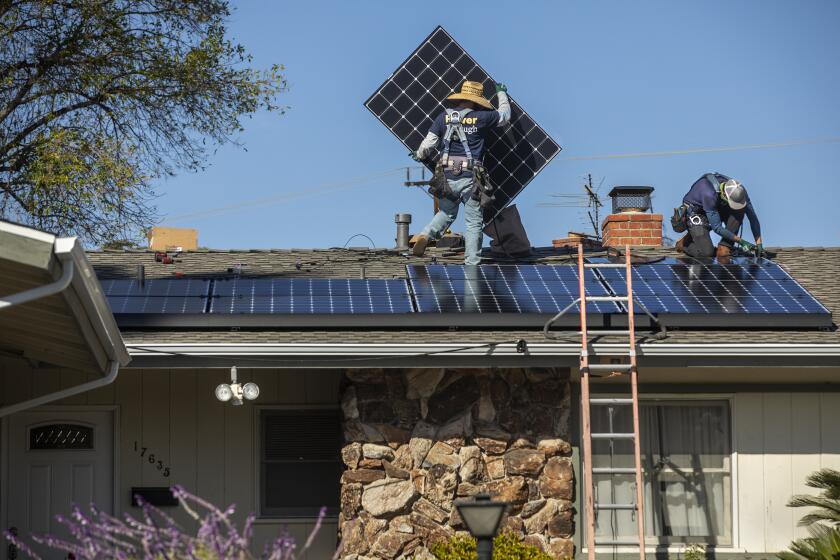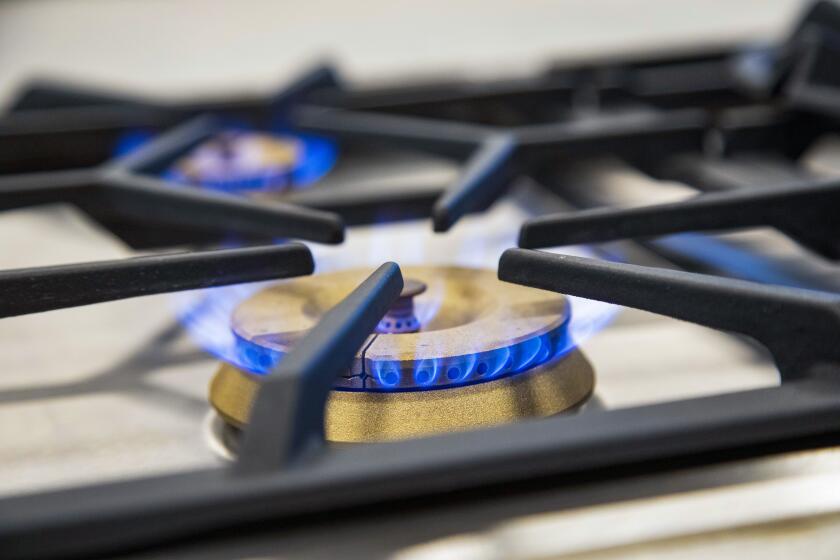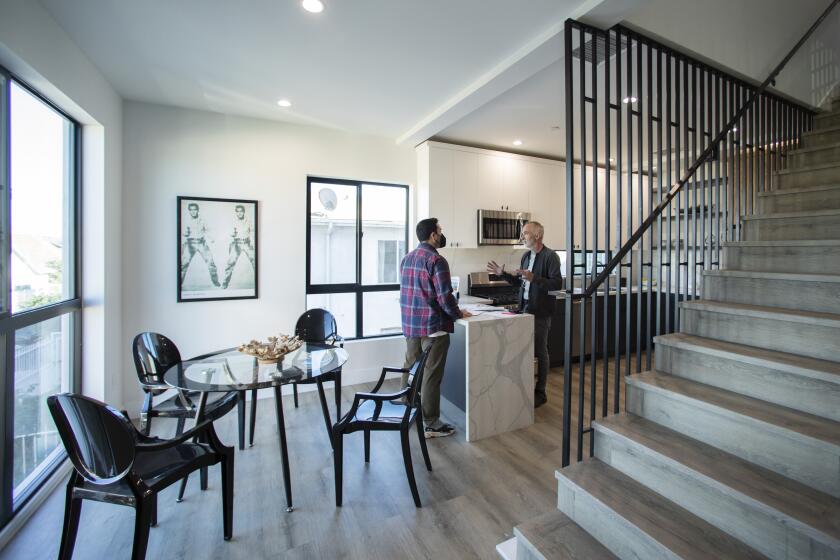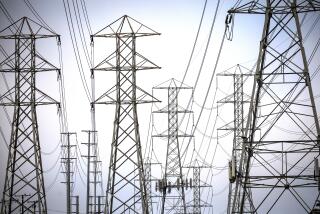An experimental green suburb rises in Riverside County. Is it the future of single-family housing?
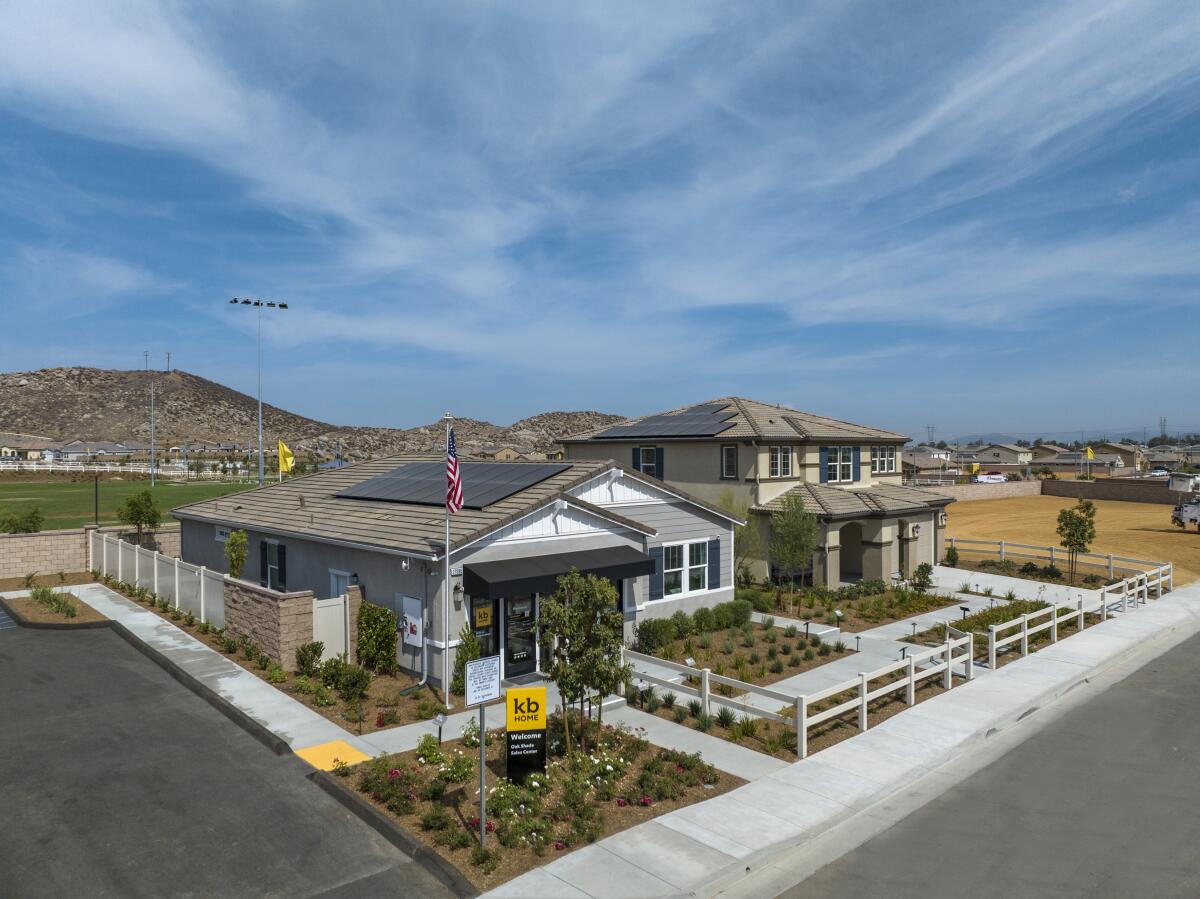
- Share via
At first glance, Durango at Shadow Mountain looks like just another cookie-cutter subdivision of new homes sprawling across an arid valley in the Riverside County town of Menifee.
Walk into a $577,990 model home on Hopscotch Drive, though, and the possible future of low-carbon, climate-resilient housing comes into view behind the stucco and faux-stone facade.
In the garage, a sleek white battery attached to one wall stores electricity generated by the 16 solar panels on the roof. Next to the battery is an electric vehicle charger, and some homeowners will have the ability to tap their car’s battery to supply additional energy to their house — an experiment to transform EVs into mobile power plants.
A high-efficiency electric heat pump water heater is tucked into one corner of the garage and a heat pump that warms and cools the house sits next to the backyard patio. The open-plan kitchen in the 2,906-square-foot, four-bedroom home features an induction stove that consumes less electricity than a conventional electric model and emits none of the harmful pollutants of a gas one.
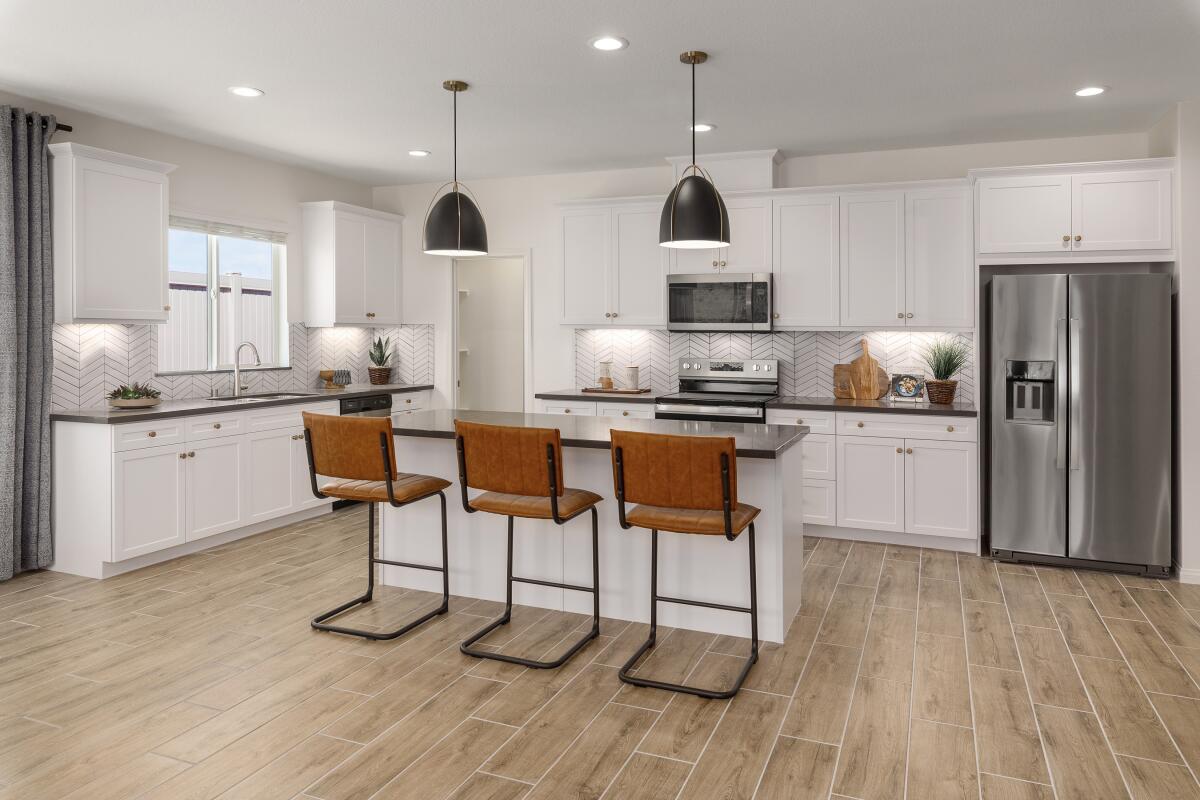
Altogether, these appliances will reduce energy consumption up to 40% in Durango compared with a conventional home, according to builder KB Home.
But what you can’t see is what could truly transform the energy system.
The 78 homes under construction at Durango are connected to form a microgrid, a self-contained power system that can operate independent of California’s grid if it fails. That’s an increasingly likely occurrence as climate-driven wildfires, heat waves and storms trigger blackouts.
An additional 141 homes being built in an adjacent subdivision, called Oak Shade at Shadow Mountain, will be connected in a second microgrid that can also tap solar energy and batteries to keep electricity flowing during blackouts.
Homes and businesses would receive lower payments for clean power they send to the grid — but not as low as under an earlier proposal.
The two developments will share a 2.3-megawatt-hour “community battery” to provide additional power in the event of an outage. In energy jargon, Durango and Oak Shade are capable of being “islanded” from the power grid — archipelagos of light if the desert goes dark.
“In California, when it’s really hot and there are fires, you’re threatened with the power turning off,” said Dan Bridleman, senior vice president for sustainability, technology and strategic sourcing at KB Home. “We felt like there was probably an affordable way to build resiliency, not only at the house level but also into the community.”
So far, KB Home executives say, about 50 houses have been sold, and the first owners are expected to move in early next year. With prices ranging from $482,000 to $578,000, the houses are attracting young families priced out of coastal cities, the company said.
Collaborating with KB Home on the project are solar energy company SunPower Corp., utility Southern California Edison, automaker Kia Corp., UC Irvine, Schneider Electric and the U.S. Energy Department.
The federal government has provided $6.65 million to develop and test first-of-its-kind microgrid technology and determine whether the Menifee microgrid could serve as a model for future housing developments. Over the next four years, a team at SunPower and researchers at UC Irvine will gather data and monitor the microgrids’ performance.
Gas stoves may emit unhealthful pollutants even when not in use, a study finds. High levels of cancer-causing benezene were found in Southern California.
“We want to see how we can improve resilience for the homeowner,” said Ram Narayanamurthy, emerging technologies program manager at the Energy Department. “Electrification is really going to drive carbon footprint reduction as the California grid gets more and more decarbonized.”
Microgrids, of course, won’t stop the spread of far-flung housing developments and climate-unfriendly strip malls, parking lots and long commutes that come with them. But they do offer a way to decarbonize suburban sprawl.
They can also “increase electricity grid reliability, play a role in mitigating wildfire risk [and] help make communities more resilient,” said Terrie Prosper, a spokesperson for the California Public Utilities Commission, the state energy regulator.
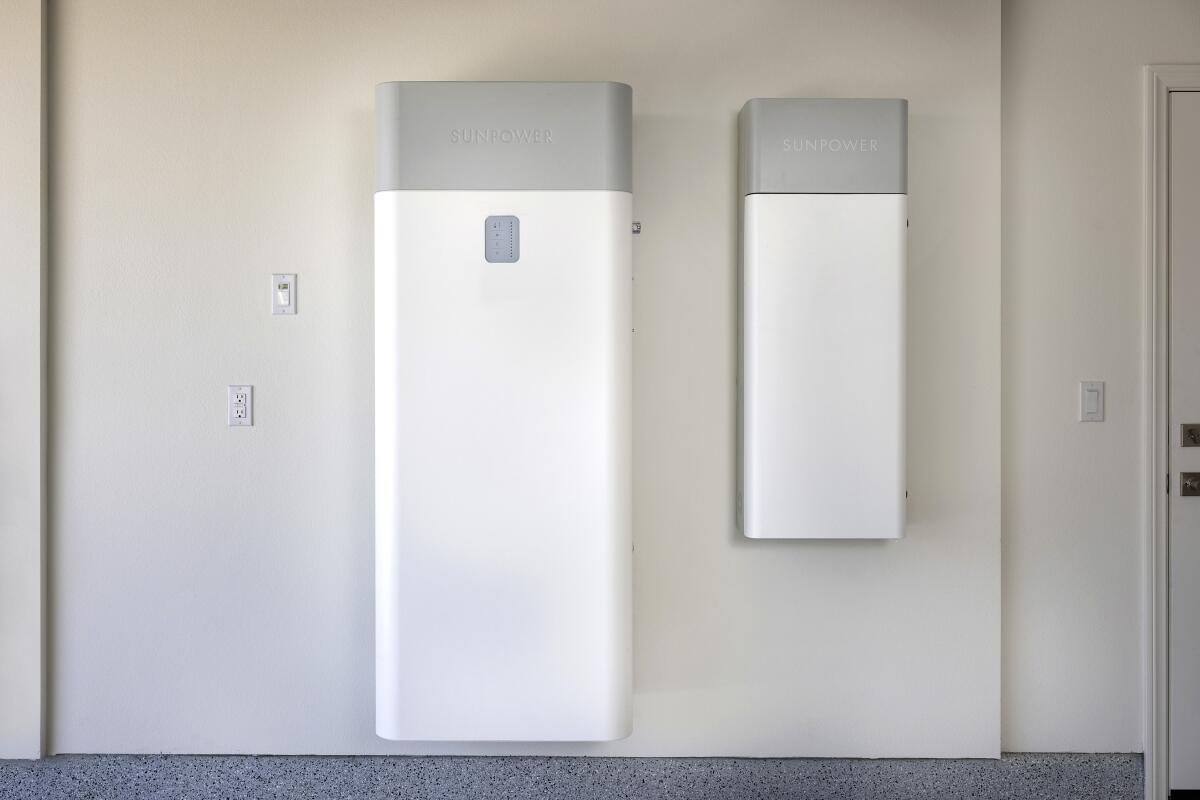
While other Menifee residents are subject to rising electricity and natural gas prices, homeowners at Durango and Oak Shade will become power brokers. They’ll be able to sell excess electricity generated by their solar panels and stored in their home battery to Southern California Edison.
Collectively, the homes in the microgrids can act as virtual power plants, supplying electricity to help keep the grid stable during surges in demand, such as during heat waves.
Each home’s battery is a 13-kilowatt-hour SunVault model from SunPower, which is also supplying the rooftop solar panels. The heat pumps and smart thermostats are Wi-Fi-enabled, allowing a home’s appliances, batteries and solar array to be coordinated to maximize energy production and reduce costs.
That means, for instance, that the 219 heat pump water heaters in Durango and Oak Shade can be transformed into “thermal batteries.” In the middle of the day, excess electricity generated by a home’s solar array heats water for use later, when the sun isn’t shining and utility rates rise. That can reduce the need to fire up natural gas power plants to meet nighttime demand.
SunPower’s technology manages a house’s energy system for homeowners, enabling the homes to engage in energy arbitrage while their inhabitants are at work or sleeping. If a Durango resident commutes to a job in San Diego, for example — ideally in an electric car — the SunPower cloud can maximize the solar electricity the resident is selling to the utility or storing in their battery by turning down the thermostat and putting appliances in economy mode.
Just 2.8% of scripts include any mention of global warming, USC researchers found.
When that same resident’s utility rates surge, the house can draw on the solar electricity stored in the battery. All homes are pre-wired for EV chargers, and about 20% of buyers so far are having them installed during construction, said Matt Brost, a SunPower vice president.
“During the high solar production hours of the day when homes often aren’t using much electricity, we believe the solar systems will more than sufficiently charge both the batteries in the homes and the community battery,” Brost said.
Microgrids could cut into utility revenues, but Southern California Edison supports the Menifee project for its potential to lower customer costs and make the grid more resilient, said Katie Sloan, the company’s vice president of customer programs and services. “This project will be a great blueprint for electrification in the future,” she said.
On a November day, construction workers at Oak Shade were assembling the wood frames of a row of two-story houses with views of rocky, chaparral-covered hills. At the edge of the development, Scott Hansen, vice president of forward planning for KB Home’s Inland Empire division, points out a patch of dirt where the community battery will be installed on a fenced-in platform. The battery, about the size of a shipping container, will normally be charged by the grid, drawing solar electricity from the surrounding houses only when needed.
Back at the Durango model home, Hansen gestures at the 5.6-kilowatt rooftop solar array. It’s about half the wattage — and cost — of a solar system typically needed to power a similar-size conventionally constructed home. That’s because houses in Durango and Oak Shade are being built to the Energy Department’s Zero Energy Ready Home standard, which requires a building to be so well-insulated and sealed that a renewable energy system can offset most or all of its energy use.
The average rate on a 30-year fixed-rate mortgage rose above 7% for the first time since 2002, according to a widely watched survey from Freddie Mac.
Hansen opened a large white panel attached to one side of the house, revealing the Schneider Electric Square D Energy Center. This smart panel controls every circuit in the home, balancing the electrical loads generated by different appliances and allowing the homeowner to choose which ones to power in a blackout.
Green labels indicate circuits that would be powered by the home battery in the event of an outage, including the lights, power outlets (keeping the Wi-Fi on), the refrigerator and the microwave oven. High-voltage appliances such as the stove and heat pumps are labeled in gray and would remain offline until the community battery kicks in and provides an extra 6 kilowatt-hours of electricity per house.
“These homes are built so tight that if the power goes out, they’ll stay cool for a longer period of time in the summer and the opposite in the winter,” Hansen said.
Once the community battery comes online, Brost said, “it will effectively power the whole home, but the homeowner is not going to be able to run everything simultaneously or charge a car, so they will have to choose what they want to run.”
Some homeowners will have one more option during a blackout: Using their car to charge their house. Five houses in Durango and five in Oak Shade are being installed with bi-directional chargers made by Spanish company Wallbox that can transfer electricity from an electric vehicle battery to the house.
Although the Ford F-150 Lightning is the only EV sold in the U.S. with that capability, these homeowners can participate in a three-year trial to lease Kia EV6 crossovers imported from South Korea that have bi-directional batteries, said Scott Samuelsen, a professor of mechanical, aerospace and environmental engineering at UC Irvine, which will design and manage the experiment.
The Kia EV6 models sold in the U.S. have battery capacities that range from 58 kilowatt-hours to 77.4 kilowatt-hours — up to six times the storage of the SunVault home battery. Samuelsen said it’s enough to keep a home powered for hours or even days during a blackout, and the kind of thing he expects “to be an integral attribute of an electric vehicle in the future.”
For Bridleman of KB Home, the convergence of all these technologies in the home is fast becoming a selling point, particularly as climate change affects daily life.
“People in California have an acute awareness of this,” he said. “We see interest across the state on how to make our homes more resilient.”
More to Read
Inside the business of entertainment
The Wide Shot brings you news, analysis and insights on everything from streaming wars to production — and what it all means for the future.
You may occasionally receive promotional content from the Los Angeles Times.
